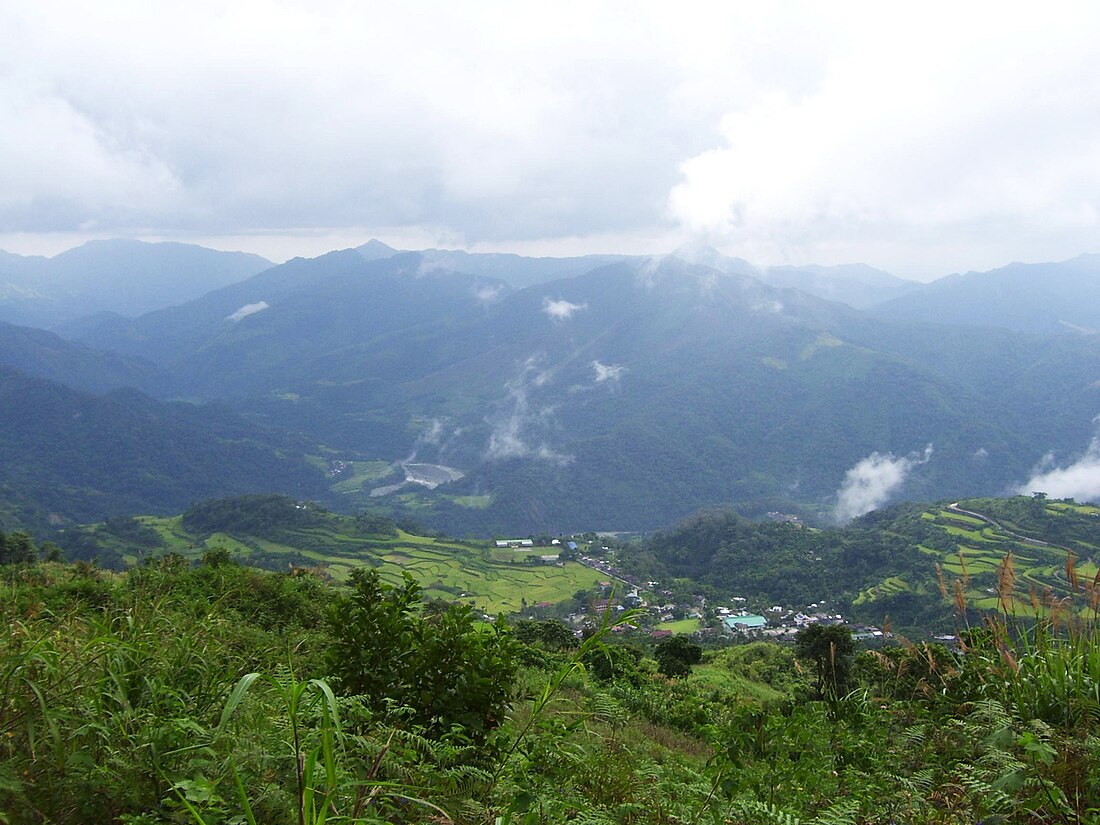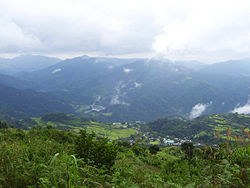Top Qs
Timeline
Chat
Perspective
Lubuagan
Municipality in Kalinga, Philippines From Wikipedia, the free encyclopedia
Remove ads
Lubuagan, officially the Municipality of Lubuagan is a municipality in the province of Kalinga, Philippines. According to the 2020 census, it has a population of 9,323 people.[5]
This article needs additional citations for verification. (January 2014) |
Lubuagan served as the seat of the National Government from March 6 to May 17, 1900, during the time of Gen. Emilio Aguinaldo. It is located at 800 metres (2,600 ft) above sea level in the southern part of Kalinga and in the heart of the Cordillera. It has a land area of 23,420 hectares (57,900 acres).
Remove ads
History
Summarize
Perspective
Spanish Rule was never established in Lubuagan during its 300 year occupation of the Philippines. However, Emilio Aguinaldo, president of the erstwhile First Philippine Republic made Lubuagan the seat of government for 73 days, from 6 March to 18 May 1900, before his escape and eventual capture at Palanan, Isabela, on 23 March 1901.[6][7]
Upon the assumption of the United States of America as colonial power over the Philippines, the Township of Lubuagan was established in 1905 and administered via the sub provincial government of Lepanto-Bontoc sub-province. Lt. Governor E. A. Eckman, an American ex-soldier was the Chief Executive of the sub-province.
In 1907, Kalinga was separated and organized as a distinct sub-province from Lepanto-Bontoc. Franklin Walter Hale was appointed the first Lt. Governor to establish a civil government in Kalinga. Hale initially established his office in Bulanao, but moved to Lubuagan in 1909 following an outbreak of cholera and malaria. Hale whom the people baptized and fondly called Sapao, first organized his police contingent from and among the tribal pangats and headmen from the different villages of Kalinga to help them tame recalcitrant natives.
Hale served Kalinga up to the end of July 1915. He was replaced by Samuel Kane, who served for a brief period and was replaced by Alex Gilfilan in September 1916, who was later on replaced by Deputy Governor Thomas Blanco, a Filipino. In 1924, Nicasio Balinag took over as Deputy Governor.
The colonial government notably beginning with the administration of Hale up to the Commonwealth government was considered the golden years of Lubuagan, which was designated the capital town of the sub-province before Tabuk rose to its present status as the center of learning and government activities. Lubuagan at that time was the center of education, culture, commerce and trade. The founding of the Kalinga Academy in 1927, a secondary school run by American Missionaries and the St. Teresita's School in 1929, a Catholic Primary and High School managed by the CICM Belgian Missionaries bolstered the luster of Lubuagan. It was also in Lubuagan where the first instruction of higher learning in the old Mountain Province was established.
During World War II, Japanese forces occupied Lubuagan in May 1942.
In 1945, Lubuagan was bombed by American planes resulting in the destruction of the Lubuagan Central School which was then occupied by the Japanese. St. Peter's church, its convent and two more buildings within its compound were all burned to the ground.
Remove ads
Geography
Lubuagan is situated 6.44 kilometres (4.00 mi) from the provincial capital Tabuk, and 471.88 kilometres (293.21 mi) from the country's capital city of Manila.
Barangays
Lubuagan is politically subdivided into 9 barangays. Each barangay consists of puroks and some have sitios.
- Antonio Canao
- Dangoy
- Lower Uma
- Mabilong
- Mabongtot
- Poblacion
- Tanglag
- Uma del Norte (Western Uma)
- Upper Uma
Climate
Remove ads
Demographics

In the 2020 census, the population of Lubuagan was 9,323 people,[14] with a density of 40 inhabitants per square kilometre or 100 inhabitants per square mile.
Economy
Poverty incidence of Lubuagan
10
20
30
40
50
60
70
2000
62.12 2003
50.37 2006
35.60 2009
24.80 2012
26.14 2015
26.60 2018
20.23 2021
7.52 Source: Philippine Statistics Authority[15][16][17][18][19][20][21][22] |
Government
Local government
Lubuagan, belonging to the lone congressional district of the province of Kalinga, is governed by a mayor designated as its local chief executive and by a municipal council as its legislative body in accordance with the Local Government Code. The mayor, vice mayor, and the councilors are elected directly by the people through an election which is being held every three years.
Elected officials
Remove ads
Tourism
- St. Theresita's School, a Roman Catholic school established by the CICM missionaries in 1925, was once the educational center of the Cordillera. It was also used as a military outpost by the Japanese, Filipino and American forces during World War II.
- Mabilong Weaver's Village is the center of the ethnic weaving industry in the province. It showcases colorful ethnic backstrap weaving.
- The town has extensive and scenic rice terraces (Pon-e Rice Terraces and Gapis Rice Terraces) cut into the mountains, rising 2,000 feet (610 m) from the Chico River bed.
- Batong Buhay Mines.
- Aguinaldo Hill was Emilio Aguinaldo's command post during his 72-day stay in the town. It has a panoramic view of several barangays in Pinukpuk.
- Awichon Mesa, a plateau situated at Barangay Upper Uma, between Pasil and Lubuagan, is an archaeological site where bones of a prehistoric elephant were found. It was also the landing site of American forces during World War II.
- Cadamayan Falls, at Barangay Western Uma, serves as the natural boundary of Pasil, Lubuagan and Tinglayan.
- Tiwod Spring, the "Fertility Twin Spring", is believed to be bestow children to childless couples, who take a bath on mornings and drink from it.
- Tongango Caves consists of several chambers connecting the mountains of Lubuagan, Sumadel and Tulgao.
- Belalao Mabilong View contains a view of Lubuagan Village. Visitors who come by night are said to be surprised by a sudden appearance of a lost city in the mountain.
- Manangol Viewpoint, at the top of Manangol Hill, has a panoramic view of the Chico River, Tinglayan and the rice terraces seated at the basement of the overlapping mountain.
- The Poway View Deck, at the boundary of Pasil and Lubuagan, has a view of the Pasil River.
- The Pudpud Chico Viewpoint, at the Lubuagan Central School, has a view of the Chico River and the aborted Chico Hydroelectric Dam.
- The Lubuagan Museum, located in an old American house, showcases a selection of old Chinese pottery as well as other Kalinga products.
Remove ads
Culture
- Laga Festival- From "laga", a Kalinga word which means to weave. Celebrated annually, typically in March. It is a two or three-day celebration which showcases the culture, arts, and history of Lubuagan.
Education
The Lubuagan Schools District Office governs all educational institutions within the municipality. It oversees the management and operations of all private and public, from primary to secondary schools.[24]
Primary and elementary schools
- Ag-agama Elementary School
- Colong Primary School
- Dangoy Elementary School
- Dugnac Primary School
- Latawan Elementary School
- Lubuagan Central School
- Mabilong Elementary School
- Mabongtot Elementary School
- Mallongan Elementary School
- Manangol Elementary School
- Payao Primary School
- Roadside Elementary School
- Sukiap Elementary School
- Tanglag Elementary School
- Uma Elementary School
Secondary schools
- Kalinga Academy
- Lubuagan National High School
- Senior High School in Lubuagan
- St. Theresita's School of Lubuagan
Remove ads
Notable personalities
- Jean Claude Saclag – Medalist, Kickboxing and Wushu
References
External links
Wikiwand - on
Seamless Wikipedia browsing. On steroids.
Remove ads





